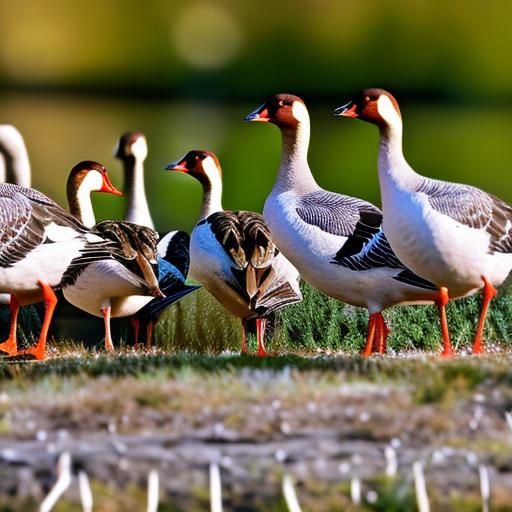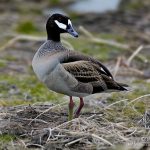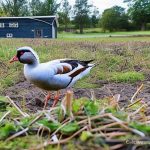Geese are highly social birds that often travel in flocks and are known for their strong family bonds. They are also territorial and can become aggressive when they feel threatened or when their nesting sites are disturbed. Understanding these behaviors is crucial when it comes to managing geese on your property. By recognizing their social nature and territorial instincts, you can better anticipate their movements and take proactive measures to deter them from settling in unwanted areas. Additionally, being aware of their nesting habits and breeding seasons can help you implement effective strategies to prevent them from establishing a presence on your property.
Geese are also known for their strong homing instincts, which means they often return to the same nesting and feeding sites year after year. This behavior can make them particularly persistent and difficult to deter once they have established a presence on your property. By understanding this behavior, you can develop long-term management plans that take into account the geese’s tendency to return to familiar locations. Overall, understanding geese behavior is essential for developing effective strategies to manage their presence on your property and minimize potential conflicts.
Key Takeaways
- Geese are social birds that prefer open areas near water and can become aggressive when nesting or protecting their young.
- Physical barriers such as fences, netting, and hedges can effectively prevent geese from accessing certain areas.
- Repellents and deterrents like sound devices, visual deterrents, and taste aversions can discourage geese from settling in an area.
- Creating an unfriendly environment by removing food sources, maintaining landscaping, and using goose-resistant plants can make an area less attractive to geese.
- Scare tactics such as motion-activated devices, trained dogs, and predator decoys can startle geese and encourage them to leave an area.
- Seeking professional assistance from wildlife management experts can provide effective and humane solutions for managing geese.
- Respecting local regulations and wildlife conservation efforts is important when implementing geese management strategies to ensure the well-being of the birds and the environment.
Implementing physical barriers
One of the most effective ways to deter geese from settling on your property is by implementing physical barriers that prevent them from accessing certain areas. This can include installing fences, netting, or other structures that create obstacles for the geese and make it difficult for them to land or nest in unwanted areas. By creating physical barriers, you can effectively control the geese’s access to your property and reduce the likelihood of them causing damage or creating safety hazards.
In addition to traditional physical barriers, there are also innovative solutions available that can help deter geese from specific areas. For example, floating barriers can be used in bodies of water to prevent geese from accessing certain areas for feeding or nesting. These barriers are designed to move with the water’s currents, making it difficult for geese to land and establish a presence. By implementing physical barriers, you can effectively manage the geese’s access to your property and create a more controlled environment that is less attractive to them.
Using repellents and deterrents
In addition to physical barriers, there are a variety of repellents and deterrents that can be used to discourage geese from settling on your property. These can include visual deterrents such as scarecrows, reflective tape, or predator decoys that create a sense of danger and make the area less appealing to geese. Additionally, auditory deterrents such as noise-making devices or ultrasonic emitters can be used to create a hostile environment that discourages geese from staying in the area.
Another effective method for deterring geese is the use of taste and odor repellents that make the area less attractive for feeding. These repellents are designed to create an unpleasant experience for the geese when they attempt to feed on grass or other vegetation, ultimately discouraging them from staying in the area. By using a combination of visual, auditory, taste, and odor repellents, you can create an environment that is unappealing to geese and effectively deter them from settling on your property.
Creating an unfriendly environment
Creating an unfriendly environment for geese is another effective strategy for managing their presence on your property. This can include modifying the landscape to make it less attractive for nesting and feeding, such as by removing tall grasses and shrubs that provide cover for geese or by installing gravel or rocks in areas where they tend to congregate. By creating an environment that is less hospitable for geese, you can reduce the likelihood of them establishing a presence on your property and minimize potential conflicts.
In addition to modifying the landscape, there are also cultural practices that can help create an unfriendly environment for geese. For example, regularly mowing grassy areas can make it less appealing for geese to feed, while using alternative landscaping materials such as mulch or gravel can discourage them from congregating in certain areas. By creating an environment that is less conducive to the geese’s needs, you can effectively manage their presence on your property and reduce the likelihood of conflicts arising.
Employing scare tactics
Scare tactics can be an effective short-term solution for deterring geese from settling on your property. This can include using visual deterrents such as scarecrows or predator decoys, as well as auditory deterrents such as noise-making devices or ultrasonic emitters that create a sense of danger and make the area less appealing to geese. By employing scare tactics, you can disrupt the geese’s sense of security and encourage them to seek out more hospitable environments.
Another effective scare tactic is the use of trained dogs to patrol the area and deter geese from settling. Dogs are natural predators to geese and their presence alone can be enough to discourage geese from staying in the area. By regularly patrolling the property with trained dogs, you can create a sense of unpredictability that makes the area less appealing for geese and reduces the likelihood of them establishing a presence.
Seeking professional assistance

If you are facing persistent issues with geese on your property, it may be necessary to seek professional assistance from wildlife management experts. These professionals have the knowledge and experience to develop comprehensive management plans tailored to your specific needs and can provide guidance on the most effective strategies for deterring geese from settling on your property. Additionally, they can help implement long-term solutions that address the root causes of the issue and minimize potential conflicts with geese.
Wildlife management professionals can also provide valuable insight into local regulations and wildlife conservation efforts that may impact your ability to manage geese on your property. By seeking professional assistance, you can ensure that your management strategies are in compliance with local laws and regulations while also contributing to broader conservation efforts aimed at protecting wildlife habitats and minimizing human-wildlife conflicts.
Respecting local regulations and wildlife conservation efforts
When managing geese on your property, it is important to respect local regulations and wildlife conservation efforts aimed at protecting these birds and their habitats. This includes familiarizing yourself with any applicable laws or regulations related to managing geese in your area, as well as seeking guidance from local wildlife authorities or conservation organizations when developing management plans.
Additionally, it is important to consider the broader impact of your management strategies on local wildlife populations and ecosystems. By taking a proactive approach to managing geese on your property, you can contribute to broader conservation efforts aimed at protecting wildlife habitats and minimizing human-wildlife conflicts. This may include implementing habitat restoration projects or participating in community-based conservation initiatives aimed at creating more sustainable environments for wildlife.
In conclusion, managing geese on your property requires a comprehensive understanding of their behavior and the implementation of effective strategies to deter them from settling in unwanted areas. By utilizing physical barriers, repellents, deterrents, creating an unfriendly environment, employing scare tactics, seeking professional assistance, and respecting local regulations and wildlife conservation efforts, you can effectively manage the presence of geese while contributing to broader conservation efforts aimed at protecting wildlife habitats.
Looking for ways to keep geese off your property? Check out this helpful article on poultrywizard.com for tips on managing turkey coops. Understanding how to create a secure and comfortable environment for turkeys can also provide insights into deterring geese from your property.
Meet Walter, the feathered-friend fanatic of Florida! Nestled in the sunshine state, Walter struts through life with his feathered companions, clucking his way to happiness. With a coop that’s fancier than a five-star hotel, he’s the Don Juan of the chicken world. When he’s not teaching his hens to do the cha-cha, you’ll find him in a heated debate with his prized rooster, Sir Clucks-a-Lot. Walter’s poultry passion is no yolk; he’s the sunny-side-up guy you never knew you needed in your flock of friends!







